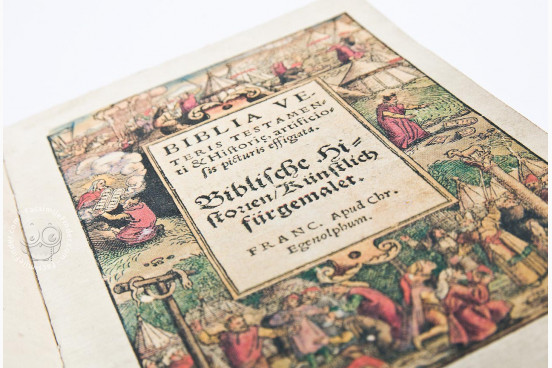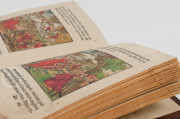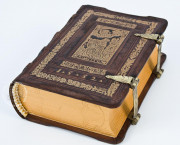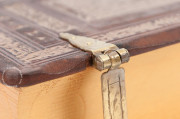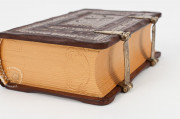The Bible of 1551 is a unique work that apart from its religious message and an ideological dimension contains unusual woodcuts, precise illustrations, and an extraordinary binding.
The volume is composed of four prints, each with a separate title page, the same print date, and publisher name. Titles in two languages, Latin and German.
1. Biblia Veteris Testamenti et Historie artificiosis picturis effigiata. Biblische Historien Künstlich fürgemalet.
2. Novi Testamenti Iesu Christi Historia effigiata. Una cum aliis quibusdam iconibus. Das New Testament und histori Christi fürgebildet.
3. Apocalypsis S. Joannis. Die Offenbarung S. Johannis.
4. Sanctorum et martyrum Christi Icones quaedam artificiossimae. Der heiligen und Martirer Gottes künstlich Bildtnussen.
The Old and New Testament and the Apocalypse are composed according to the same pattern: Illustration and applicable fragment of the Holy Bible in Latin – upper part of page and in German – at the bottom. In each case the exact location of the quote is given. Names of saints and martyrs in the last part are only given in Latin.
All parts were published in Frankfurt am Mein in the print house of Christian Egenolff in 1551.
The colophon of the New Testament even gives the month of publishing – March. Egenolff Christian, a German printer, founded the first printing house in Frankfurt am Mein. Throughout 1530-1550 he published approximately 500 prints. Many of his works were adorned with woodcuts by Hans Schauffelein and Hand Beham. He specialized in printing works about nature and history. The printing house founded by him in Frankfurt, operated by his widow and heirs, survived until 1605.
The woodcuts were probably made by Hans Sebald Beham, a German painter and printmaker, living in 1500-1550, considered by historians of art to be a member of the artistic circle created by Albrecht Durert. In 1540 he settled in Frankfurt were he established close cooperation with Egenolff.
He made illustrations for the works issued by the publisher. He specialized in illustrations for the Bible, the prominent of which is the so-called Nuremberg edition of the New Testament of 1524. Although the book bears no indication as to its author, considering everything know about this artist we can assume that he created the illustrations in the book in questions. The colors were added around the time of publication or a bit later (near the end of the first half of the 17th century).
Binding description
Bound with a board dressed with goatskin hand-dyed to a brown color. A strickle and beautiful knurl were used to decorate the binding with golden floral and figural motifs. The fronts of the covers feature gilded golden plates. Both boards are fastened with brass clasps. A date, 1552, is stamped on the front cover, it probably indicates the date the binding was made.
We have 1 facsimile edition of the manuscript "Bible of 1551": Biblia Veteris Testamenti facsimile edition, published by Orbis Pictus, 2012
Request Info / Price
